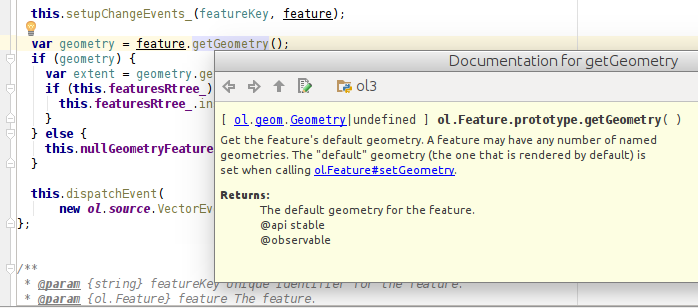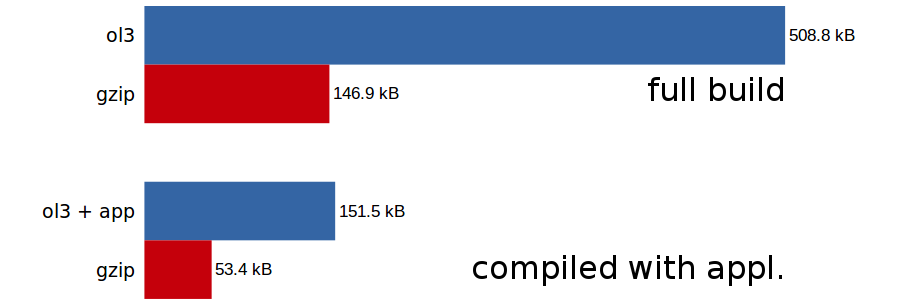Faster, smaller, better
Compiling your application together with OpenLayers 3
Tobias Sauerwein - Guillaume Beraudo
Camptocamp
Camptocamp


How do you like your OpenLayers?
(ol.js) custom build compiled
with
application
JavaScript development today
Challenges of writing large JS applications
- namespaces/modules?
- visibility control?
- type checking?
- static checking?
- testing?
Google Closure Tools
Google Closure Compiler
Google Closure Library



Google Closure Compiler
compiles JavaScript to better JavaScript
- code checks (syntax, variable references)
- checks for common pitfalls
- static type checking
- Transpiler (ES 6 > ES 5)
- advanced optimizations (inlining, dead-code)
Dead-code removal + Inlining
goog.provide('app');
app.printHello = function() {
console.log('Hello');
};
app.someUnusedFunction = function() {
console.log('Unused function');
};
app.run = function() {
app.printHello();
};
app.run();Compiled
(function(){console.log("Hello");})();Renaming
goog.provide('app');
function hello(o) {
alert('Hello, ' + o.firstName + ' ' + o.lastName);
}
app.run = function() {
var person = {firstName: 'New', lastName: 'user'};
hello(person);
console.log(person);
};
app.run();Compiled (pretty_print)
(function(){var a = {a:"New", b:"user"};
alert("Hello, " + a.a + " " + a.b);
console.log(a);
})();Exports
<button onclick="app.doSomething()">...</button>
How to prevent that app.doSomething is renamed or removed?
/**
* @export
*/
app.doSomething = function() {
...
};Type annotations
/**
* @constructor
* @param {number} x X.
* @param {number} y Y.
* @param {number=} opt_z Z.
*/
app.Point = function(x, y, opt_z) { ... };
/**
* @param {!app.Point} other An other point.
* @return {number} The distance.
*/
app.Point.prototype.distanceTo = function(other) { ... };JSDoc Tags: A selection
@const @constructor @enum @export
@extends @final @implements @interface
@nosideeffects @param @private
@protected @return @throws @type ...
Why bother with types?
Why types?
Understanding code
entries.forEach(function(entry) {
entry.data.validate();
});What does this code do?
Why types?
Static type check
var point = new app.Point([0, 0]);ERR! compile src/main.js:14: WARNING - Function app.Point:
called with 1 argument(s). Function requires at least
2 argument(s) and no more than 3 argument(s).
ERR! compile var p5 = new app.Point([0, 0]);
ERR! compile ^
ERR! compile
ERR! compile src/main.js:14: WARNING - actual parameter 1 of
app.Point does not match formal parameter
ERR! compile found : Array
ERR! compile required: number
ERR! compile var p5 = new app.Point([0, 0])
ERR! compile 0 error(s), 2 warning(s)
ERR! compile 95.5% typedWhy types?
IDE integration, refactorings

Using external libraries
Compile with application
library must be compatible to Closure Compiler
Reference library outside compilation
compilation requires an externs file
<script type="text/javascript" src="libs/jquery.min.js"></script>
<script type="text/javascript" src="build/app.js"></script>Externs files
var map = L.map('map').setView([0, 0], 13);ERR! compile src/main.js:4: ERROR - variable L is undeclaredexterns file
/** @const */
var L = {};
/**
* @param {string} div
* @return {LeafletMap}
*/
L.map = function(div) {};
/** @constructor */
var LeafletMap = function() {};
...And OpenLayers?
Simple example with ol3
goog.provide('app');
goog.require('ol.Map');
goog.require('ol.View');
goog.require('ol.layer.Tile');
goog.require('ol.source.OSM');
var map = new ol.Map({
target: 'map',
layers: [
new ol.layer.Tile({source: new ol.source.OSM()})
],
view: new ol.View({center: [0, 0], zoom: 4})
});Compiler configuration
{
"lib": [
"node_modules/openlayers/src/**/*.js",
"node_modules/openlayers/build/ol.ext/**/*.js",
"src/**/*.js"
],
"compile": {
"closure_entry_point": "app",
"externs": [
"node_modules/openlayers/externs/bingmaps.js",
...
],
"define": ["ol.ENABLE_DOM=false", "ol.ENABLE_WEBGL=false"],
"compilation_level": "ADVANCED",
"output_wrapper": "(function(){%output%})();",
...
}
}Tooling
compiler.jar
Closure Compiler as Java CLI tool
closure-util
npm package, wrapper around compiler.jar, dev. server
closure-util build config.json dist/app.js
closure-util serve config.json
Why compile with OpenLayers?
- Only pay for what you use (build size)
- Easier to extend OpenLayers
- Benefit from the advantages of the Closure Compiler (static/type checking, efficient code, ...)
Build sizes

Example projects
- openlayers/ol3
- openlayers/ol3-cesium (ol3 + Cesium)
- camptocamp/ngeo (ol3 + Angular)
- Geoportail-Luxembourg/geoportailv3 (ol3 + ngeo + Angular)
- geoadmin/mf-geoadmin3 (ol3 + Angular + Cesium)
- SwitzerlandMobility (ol3 + ngeo + Angular + Cesium)
- camptocamp/provelobern_bicyclerouteplanner (ol3 + ngeo + Angular)
- ...
Learning curve?
Resources: How to get started
- OpenLayers 3 Tutorial: Compiling Application with Closure Compiler
- Google Closure Documentation
- Book: Closure - The Definitive Guide by Michael Bolin
- Annotating JavaScript for the Closure Compiler
- Google I/O 2011: JavaScript Programming in the Large with Closure Tools
- Externs files
- Compiler options
- closure-util
- More resources
- Examples used in this talk
Future / Alternatives
- Support for ES 6 modules in OpenLayers 3 (module bundlers: tree-shaking)
- Closure Compiler is a transpiler (ES 6 > ES 5)
- TypeScript
This talk
Slides
bit.ly/ol3-closure
Find us on GitHub/Twitter
Tobias: @tsauerwein


Guillaume: @gberaudo


Credits for these great photos!





